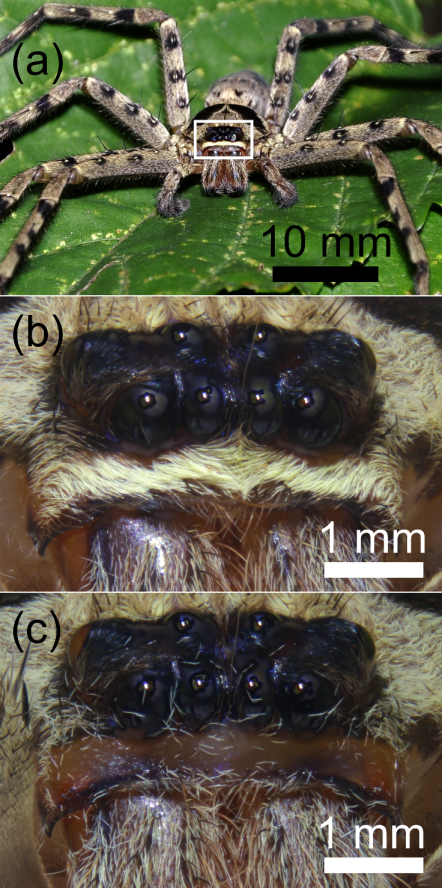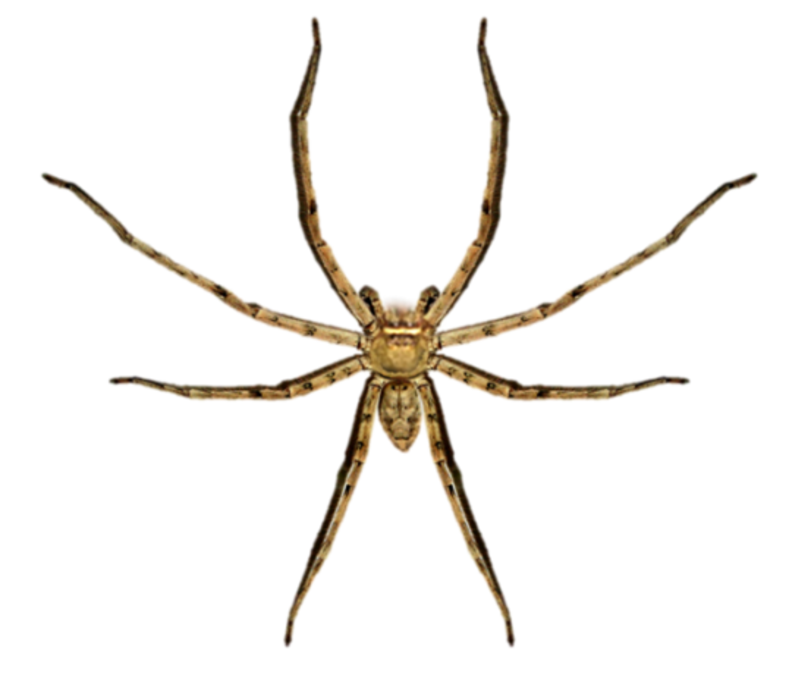This blog is part of our colourful countdown to the holiday season where we’re celebrating the diversity and beauty of the natural world. In this post, Shichang Zhang of Hubei University unravels the role of body coloration on prey capture and predator avoidance in spiders.
Animals have evolved a variety of body colours during evolution. The body colour of spiders is best known for its importance in courtship, especially in jumping spiders. It is not clear, however, whether body colour plays any other important roles in their lives.
The brown huntsman spider, Heteropoda venatoria (Araneae: Sparassidae), is a large nocturnal cursorial predator with a moustache-like white stripe across its forehead region, which contrasts with its surroundings at night. In a different way from other wandering spiders, it usually perches on the ground, tree trunks or rocks, waiting for prey. We observed in the field that it can jump and snatch flying insects out of the air when prey approach closely enough. Thus, we hypothesised that the conspicuous white stripe functions to attract nocturnal insects.
To test our hypothesis, we made dummy spiders out of cardboard and manipulated the colour signal of the white stripes in both live and dummy spiders. We then monitored nocturnal prey responses to different treatment groups in the field using infrared video cameras. The results showed that the dummy spiders with the white stripe lured significantly more flying insects compared to those without the white stripe, but there was no significant difference in the rate of attraction to non-flying prey. Similarly, live spiders with the white stripe attracted significantly more flying prey (60% of which are Lepidoptera moths) than live spiders with the white stripe removed .

In our field survey on the brown huntsman spider we found that the area of the white stripe varies among individuals, leading us to question whether the white stripe played an important role in sexual selection – i.e. the bigger the white stripe, the more attractive it may be to the prey, so spiders with such characteristics may have an advantage in sexual selection.
To test this hypothesis, we artificially removed the male spiders’ white stripe or covered the eyes of the females in the laboratory, while using untreated spiders as controls. The spiders were then subjected to mating assays. The results showed that males that courted females with intact vision had a significantly lower probability of mating success than males that courted females whose vision was blocked . In addition, females with intact vision were also more likely to choose males with a white stripe than those whose stripe was removed.

Besides function in foraging, body coloration of spiders also plays an important role in predator avoidance. It is known that many web spiders use silk, leaf litter, moults, egg sacs and prey remains in their webs to build “detritus decorations”.
Cyclosa monticola (Araneae: Araneidae) is one such spider that decorates its webs with a column of detritus decoration. The detritus decoration has the similar coloration as the body coloration of the spider, with its main function suggested as being to conceal the spider from the detection of a predator, such as predatory wasps and birds. However, empirical evidence is scare.
We hypothesised that the detritus decoration constructed by C. monticola may deflect the attention and thus the attack of birds. To test this hypothesis, we first measured the reflectance spectra of the decoration and the spider body, and found that their reflectance was similar. Then, we conducted predatory experiments in the laboratory using naïve chicks as predators. We put the chicks in a cage containing a web either with (S+) or without (S−) a spider and either with (D+) or without (D−) detritus decoration (a total of four types of webs: S+D+, S+D−, S−D+ and S−D−) under both natural habitat background and white background.

Our results showed that under two background conditions, the presence of the spider and/or decoration can attract the attention of chicks. However, the frequency of first attacks at the spiders was significantly affected by the presence/absence of spiders or decorations (i.e. S+D+, S+D−). In the presence of decorations (S+D+), the spiders were 30.2 times less likely to be attacked by chicks than in the absence of decorations (S+D−).
Next, we used visual models to test whether birds can visually distinguish the body colour of C. monticola from the colour of its decoration with the receptor noise limited (RNL) colour discrimination model. Chromatic and achromatic contrasts estimated from the RNL modelling were summarised as in the unit of ‘just noticeable distances’ (JNDs). We considered JND values above 3.00 as easily distinguishable, values between 1.00 and 3.00 were distinguishable only in good light conditions and values below 1.00 as a threshold for indistinguishable colour. The results showed that birds could not distinguish the body colour of the spider from the colour of its decoration.
We also found that the rate of attack of C. monticola and their decorations was not random, the decorations were more likely to be attacked than spiders, regardless of the ratio of surface area of decorations to spider bodies when both spiders and decorations were presented (S+D+). Therefore, our results together support a deflection hypothesis of the detritus decorations.
To sum up, our studies showed that the body colours of spiders play important roles in their life history, especially in foraging and defence, thus strengthening our understanding of the function and evolution of animal body coloration.
Discover more posts as part of our Colour Countdown series here.

Thaks bro!
Nice Post!
LikeLike